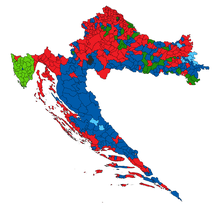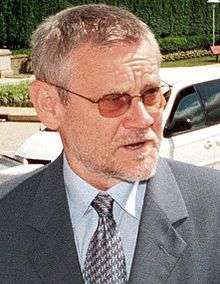2000 Croatian parliamentary election
Parliamentary elections for the Chamber of Representatives of the Croatian Parliament were held on 3 January 2000. These were the first elections to be held after the expiration of a full 4-year term of the previous Chamber of Representatives.
| |||||||||||||||||||||||||||||||||||||||||||||||||||||
All 151 seats to Chamber of Representatives 76 seats needed for a majority | |||||||||||||||||||||||||||||||||||||||||||||||||||||
|---|---|---|---|---|---|---|---|---|---|---|---|---|---|---|---|---|---|---|---|---|---|---|---|---|---|---|---|---|---|---|---|---|---|---|---|---|---|---|---|---|---|---|---|---|---|---|---|---|---|---|---|---|---|
| Turnout | 70.5% | ||||||||||||||||||||||||||||||||||||||||||||||||||||
| |||||||||||||||||||||||||||||||||||||||||||||||||||||
 Results of the election in each of the ten electoral districts of Croatia: the party with the majority of votes in each electoral unit. SDP-HSLS coalition: red; HDZ: blue | |||||||||||||||||||||||||||||||||||||||||||||||||||||
| |||||||||||||||||||||||||||||||||||||||||||||||||||||


SDP-HSLS coalition
HDZ
HSS-HNS coalition
IDS-HSS-HNS coalition
SDSS
HSP-HKDU coalition
HČSP
The ruling Croatian Democratic Union entered the elections weakened by the Zagreb Crisis, street protests and the series of corruption scandals that came to light in the previous parliamentary term. However, the most important factor was the deteriorating health of the party leader and Croatian president Franjo Tuđman, which sparked a succession struggle between various factions within the party.
On the other side, two major Croatian opposition parties - the Social Democratic Party of Croatia and Croatian Social Liberal Party - had their coalition formally agreed in 1998 and spent more than a year preparing for the elections. At first, they were to run together with the Croatian Peasant Party, Croatian People's Party, Istrian Democratic Assembly and Liberal Party, but as Tuđman's condition worsened leaders of the SDP and HSLS concluded that they could win elections even without those four other parties which later formed a separate bloc.
Like before all previous elections since the breakup of Yugoslavia, the electoral laws were altered in an attempt to improve the chances for the ruling party; this included a new voting system and redistricting. The First Past the Post constituencies introduced in the previous election were completely abandoned and Proportional Representation was implemented (with the exception of single representative ethnic minority seats). Croatia was divided into ten electoral districts, all drawn in order to maximise the support for HDZ. Each district had to elect 14 members, with candidates' lists having to win more than 5% of the votes in order to be represented in the Sabor.
Due to Tuđman's illness and death, the actual date of elections had been repeatedly postponed for constitutional reasons. There were speculations about elections being held during the Christmas holidays in order to have as many Croatian expatriates (traditional HDZ supporters) in the country, but the date of 3 January was chosen as the most suitable. As the day of the elections approached, its outcome became more certain. The campaign was brief and relatively uneventful with the HDZ being visibly weakened and demoralised by the death of its long-term leader. On the actual day of elections the turnout - the biggest since 1990 - indicated the Croatian people's desire to have their government changed.
Račan was appointed Prime Minister on 27 January 2000, by a decree of the Acting President of Croatia and Speaker of the outgoing assembly of Parliament, Vlatko Pavletić, and this decision was later confirmed by a parliamentary vote on 2 February 2000 in which 122 of 151 MPs voted in favor and 1 against the cabinet, while 1 MP abstained.[1] Račan led a coalition of SDP and HSLS, which together with a bloc of four other parties held two-thirds majority in Parliament, allowing them to amend the Constitution and transform Croatia from a semi-presidential system into an incomplete parliamentary system in November 2000 and abolish the upper chamber of Parliament, the Chamber of Counties, in March 2001. The constitutional changes of 2000 greatly limited the power of the president, but retained the direct election of that office.
Summary of votes and seats
Summary of the 3 January 2000 Croatian Parliament (Hrvatski Sabor) election results
| Parties and coalitions | Votes | % | Seats | % | Seat trend | Seat change (%) | |
|---|---|---|---|---|---|---|---|
| Coalition: | 1,138,318 | 38.70 | |||||
| Social Democratic Party (Socijaldemokratska partija Hrvatske) | 43 | 28.48 | +20.7 | ||||
| Croatian Social Liberal Party (Hrvatska socijalno liberalna stranka) | 25 | 16.56 | +7.11 | ||||
| Alliance of Primorje-Gorski Kotar (Primorsko goranski savez) | 2 | 1.32 | +0.54 | ||||
| Slavonia-Baranja Croatian Party (Slavonsko-baranjska hrvatska stranka) | 1 | 0.66 | -0.12 | ||||
| Croatian Democratic Union (Hrvatska demokratska zajednica) | 784,192 | 26.88 | 46 | 30.46 | -28.60 | ||
| Coalition: | 432,527 | 14.70 | |||||
| Croatian Peasant Party (Hrvatska seljačka stranka) | 16 | 11.26 | +3.39 | ||||
| Istrian Democratic Assembly (Istarski demokratski sabor/Dieta democratica Istriana) | 4 | 2.65 | +0.31 | ||||
| Croatian People's Party (Hrvatska narodna stranka) | 2 | 1.32 | -0.24 | ||||
| Liberal Party (Liberalna stranka) | 2 | 1.32 | +1.32 | ||||
| Social Democratic Action of Croatia (Akcija socijaldemokrata Hrvatske) | 0 | 0.00 | -0.78 | ||||
| Coalition: | 153,708 | 5.19 | |||||
| Croatian Party of Rights (Hrvatska stranka prava) | 4 | 2.65 | -0.50 | ||||
| Croatian Christian Democratic Union (Hrvatska kršćanska demokratska unija) | 1 | 0.66 | +0.66 | ||||
| Others | - | ||||||
| Valid Votes | 2,899,935 | ||||||
| Invalid Votes | 47,926 | ||||||
| Votes Cast | 2,947,861 | ||||||
| Registered Voters | 4,046,488 | ||||||
| Autohtone nacionalne manjine | |||||||
| Serb People's Party (Srpska narodna stranka) | 12,396 | 1 | |||||
| Democratic Union of Hungarians of Croatia (Demokratska zajednica Mađara Hrvatske) | 1,892 | 1 | |||||
| Italian minority (independent candidate) | 5,152 | 1 | |||||
| Croatian Peasant Party (Hrvatska seljačka stranka) | 1,401 | 1 | |||||
| Russian and Ukrainian Alliance of the Croatian Republic (Savez Rusina i Ukrajinaca Republike Hrvatske) | 342 | 1 | |||||
| Total | 151 | ||||||
| Source: HIDRA,[2] Adam Carr's Election Archive[3] | |||||||
National minorities elected 5 representatives through a separate election system: Milan Đukić (47,7% of votes) for the Serb national minority, Tibor Santo (42,8%) for the Hungarian minority, Furio Radin (78,9%) for the Italian minority, Zdenka Čuhnil (40,6%) for the Czech and Slovak minorities and Borislav Graljuk (34,1%) for the Austrian, German, Jewish, Rusyn and Ukrainian minorities.
Composition of Parliament
| Government | Opposition | ||||||||||||||||||||||||||||||||||||||||||||||||||||||||||||||||||||||||||||
|---|---|---|---|---|---|---|---|---|---|---|---|---|---|---|---|---|---|---|---|---|---|---|---|---|---|---|---|---|---|---|---|---|---|---|---|---|---|---|---|---|---|---|---|---|---|---|---|---|---|---|---|---|---|---|---|---|---|---|---|---|---|---|---|---|---|---|---|---|---|---|---|---|---|---|---|---|---|
| |||||||||||||||||||||||||||||||||||||||||||||||||||||||||||||||||||||||||||||
 |
|---|
| This article is part of a series on the politics and government of Croatia |
|
Executive |
|
Legislative
|
|
|
|
References
- http://www.hsp1861.hr/vijesti/200210nlir.htm
- "Službeni rezultati izbora zastupnika za Zastupnički dom Hrvatskoga državnog sabora održanih 2. i 3. siječnja 2000". Croatian Information-Documentation Referral Agency (HIDRA). Archived from the original on 2003-10-23. Retrieved 2011-11-21.
- State Electoral Commission. "Republic of Croatia - Legislative election of 3 January 2000". Adam Carr's Election Archive.

